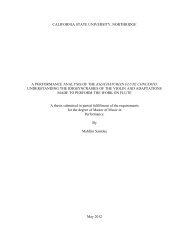2644 - CSUN ScholarWorks - California State University, Northridge
2644 - CSUN ScholarWorks - California State University, Northridge
2644 - CSUN ScholarWorks - California State University, Northridge
You also want an ePaper? Increase the reach of your titles
YUMPU automatically turns print PDFs into web optimized ePapers that Google loves.
Journal of Student Research Abstracts · 49<br />
absorbed by sodium hydroxide. 5mL of elodea was put in a volumeter, an apparatus to measure the volume of<br />
oxygen intake. The experiment was set at two different temperatures, l9°C and 34°C, and the oxygen intake<br />
by elodea was measured. With the use oft-test, the result showed that at 34 °C, there was more oxygen intake<br />
by the elodea than at 19°C. The result supported the hypothesis that a higher temperature would lead to a higher<br />
respiration rate of elodea. It also supported the idea that a higher temperature would lead to a faster metabolism<br />
due to a higher enzyme activity.<br />
2746<br />
EFFECT OF VITAMIN C ON FUNGAL GROWTH.<br />
Heather Kadani and Steve De.Gusta (teacher). John F. Kennedy High School, 6715 Gloria Drive,<br />
Sacramento, CA 95831.<br />
This is one in a series of experiments to determine if Vitamin C can help cells resist a harmful element, as<br />
it has been speculated that Vitamin C helps resistance to the common cold. The subject used is fungus<br />
(Phycomyces blakesleeanus) and the harmful element is fungicide. The effect of Vitamin C on the growth is<br />
unknown. It could halt the growth. If so, this must be determined before further experiments can be done using<br />
Vitamin C and fungus.<br />
In this experiment, the effects of Vitamin C on fungal growth were tested. One group of fungus was grown<br />
on nutrient agar with .0034 mg/ ml Vitamin C. The control was grown on agar without Vitamin C. For two days<br />
the colonies' diameters were compared. For both days, the means of the diameters were equal for the experimental<br />
and control groups (t=o, p> .1), indicating that Vitamin C has no effect on Phycomyces blakesleeanus<br />
growth. This is excellent news because now future experiments can be carried out using Phycomyces<br />
blakesleeanus and Vitamin C.<br />
2747<br />
THE EFFECTS OF RADIATION ON THE PREFERENCE OF FOOD FOR<br />
COMMON GARDEN SNAILS.<br />
Ken Kurahara and Steve DeGusta (teacher). John F. Kennedy High School, 6715 Gloria Dr., Sacramento,<br />
CA 95831.<br />
The purpose of this experiment was to test snails to see if they have any preference between lettuce leaves<br />
that have been subjected to microwave radiation and normal lettuce leaves. First, I microwaved lettuce leaves<br />
on low power to minimize heat but allow radiation. I did this to show that microwaving kills the majority of<br />
microorganisms on the leaf's surface. This confirmed that the lettuce leaves were in fact being irradiated. After<br />
this preliminary experiment, I went on to test for preference in common garden snails on irradiated lettuce and<br />
not irradiated lettuce. I cut two one inch squares out of both the irradiated lettuce and lettuce that was not irradiated.<br />
I placed both of the leaves on opposite sides in a sterile finger bowl. I then placed a snail in a neutral<br />
position, able to see both leaves, and observed which leaf the snail ate first. After doing this with twenty-two<br />
snails two times each, I eliminated the snails that did not move and computed statistic tests on the data. Out of<br />
44 snails, 15 remained neutral, 13 went to the lettuce that was not irradiated and 16 went to the irradiated lettuce.<br />
Using this, I found my CHF value to be 0.310 and my probability to be between 0.7 and 0.5. This allowed<br />
me to keep my null hypothesis that says all differences in the snails choice are due to chance and nothing else.<br />
From this I concluded that the snails have no preference between irradiated lettuce and lettuce that was not<br />
irradiated.













